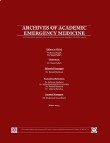The Most and Least Stressful Prehospital Emergencies from Emergency Medical Technicians’ View Point; a Cross-Sectional Study
Author(s):
Article Type:
Research/Original Article (دارای رتبه معتبر)
Abstract:
Introduction
Exposure to different prehospital emergencies (PE) may have a different impact on Emergency Medical Technicians (EMTs) based on the characteristics and circumstances of the emergency. The present study aimed to prioritize PE types according to their stressfulness as well as their correlation with post traumatic stress disorders (PTSD).
Method
In this cross-sectional study, all EMTs in the Emergency Medical Services (EMS) of Hamadan province were invited to participate, voluntarily. The study questionnaire comprised of two parts: a) personal characteristics and prioritizing PE types in terms of their stressfulness and b) The PTSD checklist. Kruskal-Wallis test was used for examining the relationship between total PTSD score and the most and the least stressful PEs. Multivariate logistic regression was also used to predict the impact of different types of PEs on PTSD.
Results
259 EMTs with the mean age of 32.79±6.16 years were studied. The total mean score of PTSD on PCL-5 was 21.60±11.45. Also, 20.1% of technicians met the criteria for PTSD. The mean age of technicians who met PTSD criteria was less than that of technicians who did not meet PTSD criteria (28 vs. 33 years, P<0.001). The most and least stressful emergencies were cardiovascular (24.7%) and environmental (26.3%) emergencies, respectively. There was a significant correlation between the most (Kruskal-Wallis=40.92, df=12, p < 0.001) and the least stressful emergencies (Kruskal-Wallis=28.22, df=15, p = 0.02) from EMTs’ viewpoint and PTSD score. Multivariate logistic analysis showed that gynecologic (aOR=2.28, Wald=5.83, p=0.016) and allergic (aOR=0.12, Wald=10.16, p=0.01) emergencies were significant predictive factors of PTSD.
Conclusion
Based on the view point of the studied EMTs, cardiac and environmental emergencies were the most and least stressful emergencies. The frequency of PTSD in this series was about 20% and it significantly correlated with younger age, lower experience, higher number of shifts, non-official employment and EMT degree. Based on multivariate logistic analysis, gynecologic and allergic emergencies were the only significant predictive factors of PTSD.Keywords:
Language:
English
Published:
Archives of Academic Emergency Medicine, Volume:7 Issue: 1, 2019
Page:
10
magiran.com/p2021431
دانلود و مطالعه متن این مقاله با یکی از روشهای زیر امکان پذیر است:
اشتراک شخصی
با عضویت و پرداخت آنلاین حق اشتراک یکساله به مبلغ 1,390,000ريال میتوانید 70 عنوان مطلب دانلود کنید!
اشتراک سازمانی
به کتابخانه دانشگاه یا محل کار خود پیشنهاد کنید تا اشتراک سازمانی این پایگاه را برای دسترسی نامحدود همه کاربران به متن مطالب تهیه نمایند!
توجه!
- حق عضویت دریافتی صرف حمایت از نشریات عضو و نگهداری، تکمیل و توسعه مگیران میشود.
- پرداخت حق اشتراک و دانلود مقالات اجازه بازنشر آن در سایر رسانههای چاپی و دیجیتال را به کاربر نمیدهد.
In order to view content subscription is required
Personal subscription
Subscribe magiran.com for 70 € euros via PayPal and download 70 articles during a year.
Organization subscription
Please contact us to subscribe your university or library for unlimited access!


